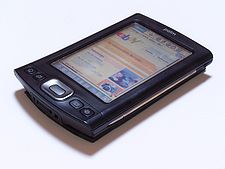TX (handheld)
|
The Palm TX
|
|
| Manufacturer | Palm, Inc. |
|---|---|
| Type | PDA |
| Retail availability | November 2005-2009 |
| Media | 128 MB Flash memory and (1) SD/SDIO/MMC slot |
| Operating system | Palm OS Garnet, 5.4.9 |
| CPU | 312 MHz Intel XScale PXA 270 |
| Memory | 32MB Random Access Memory, 128MB Flash |
| Display | 3.9 in, 320x480 px TFT LCD, 16-bit color touchscreen |
| Input | Touchscreen (stylus-based) |
| Camera | None |
| Connectivity | 802.11b Wifi, Bluetooth, IrDA |
| Power | 1250 mA·h rechargeable lithium-ion non-removable battery |
| Dimensions | 120.9x78.22x15.5 mm (4.8x3.1x0.6 in.) |
| Related articles | Tungsten T5 |
The Palm TX (written as "Palm T|X" in official documentation) was a personal digital assistant which was produced by Palm, Inc. It was announced and released as part of Palm's October 2005 product cycle, and was in production until March 2009.
It succeeded the Tungsten T5 PDA. The TX marked Palm's discontinuation of "Tungsten" sub-branding for its high-end handhelds. It featured 802.11b Wi-Fi and Bluetooth wireless connectivity. It ran Palm OS Garnet, version 5.4.9. As Palm considered the LifeDrive to be separate from its PDA line, designating it as a "Mobile Manager", the TX was Palm's flagship PDA.
The Palm TX featured a 312 MHz ARM-based Intel XScale PXA 270 microprocessor; a 320x480 transreflective screen that supported 65,000 colors; 802.11b Wi-Fi with an internal antenna; 128 MB of non-volatile storage, of which 100 MB is user accessible; an SDIO and MMC compatible SD expansion card slot; standard 3.5 mm headphone jack; infrared I/O port; single speaker capable of full audio playback; and an Athena Connector, referred to as a 'Multiconnector,' with separate data and power input. Trickle charging is possible via USB data cable.
The SD expansion card slot used 2 GB cards directly, and 4 GB capacity was usable if formatted to FAT32 with an included driver. The FAT32 driver was much slower than the FAT16 driver. Compatibility with the SDHC format could be achieved by a third party vendor add-on. To use the device as an mp3 player, it was generally necessary to use an SD card, as internal memory could not be used to store the associated mp3 files. However, it was possible to use a utility such as E2 Internal drive to use the internal memory as an SD card to store files.
...
Wikipedia

